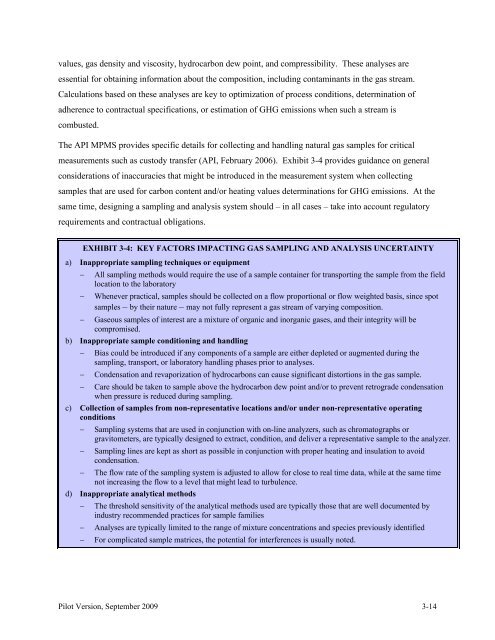addressing uncertainty in oil and natural gas industry greenhouse
addressing uncertainty in oil and natural gas industry greenhouse
addressing uncertainty in oil and natural gas industry greenhouse
Create successful ePaper yourself
Turn your PDF publications into a flip-book with our unique Google optimized e-Paper software.
values, <strong>gas</strong> density <strong>and</strong> viscosity, hydrocarbon dew po<strong>in</strong>t, <strong>and</strong> compressibility. These analyses are<br />
essential for obta<strong>in</strong><strong>in</strong>g <strong>in</strong>formation about the composition, <strong>in</strong>clud<strong>in</strong>g contam<strong>in</strong>ants <strong>in</strong> the <strong>gas</strong> stream.<br />
Calculations based on these analyses are key to optimization of process conditions, determ<strong>in</strong>ation of<br />
adherence to contractual specifications, or estimation of GHG emissions when such a stream is<br />
combusted.<br />
The API MPMS provides specific details for collect<strong>in</strong>g <strong>and</strong> h<strong>and</strong>l<strong>in</strong>g <strong>natural</strong> <strong>gas</strong> samples for critical<br />
measurements such as custody transfer (API, February 2006). Exhibit 3-4 provides guidance on general<br />
considerations of <strong>in</strong>accuracies that might be <strong>in</strong>troduced <strong>in</strong> the measurement system when collect<strong>in</strong>g<br />
samples that are used for carbon content <strong>and</strong>/or heat<strong>in</strong>g values determ<strong>in</strong>ations for GHG emissions. At the<br />
same time, design<strong>in</strong>g a sampl<strong>in</strong>g <strong>and</strong> analysis system should – <strong>in</strong> all cases – take <strong>in</strong>to account regulatory<br />
requirements <strong>and</strong> contractual obligations.<br />
EXHIBIT 3-4: KEY FACTORS IMPACTING GAS SAMPLING AND ANALYSIS UNCERTAINTY<br />
a) Inappropriate sampl<strong>in</strong>g techniques or equipment<br />
− All sampl<strong>in</strong>g methods would require the use of a sample conta<strong>in</strong>er for transport<strong>in</strong>g the sample from the field<br />
location to the laboratory<br />
− Whenever practical, samples should be collected on a flow proportional or flow weighted basis, s<strong>in</strong>ce spot<br />
samples – by their nature – may not fully represent a <strong>gas</strong> stream of vary<strong>in</strong>g composition.<br />
− Gaseous samples of <strong>in</strong>terest are a mixture of organic <strong>and</strong> <strong>in</strong>organic <strong>gas</strong>es, <strong>and</strong> their <strong>in</strong>tegrity will be<br />
compromised.<br />
b) Inappropriate sample condition<strong>in</strong>g <strong>and</strong> h<strong>and</strong>l<strong>in</strong>g<br />
− Bias could be <strong>in</strong>troduced if any components of a sample are either depleted or augmented dur<strong>in</strong>g the<br />
sampl<strong>in</strong>g, transport, or laboratory h<strong>and</strong>l<strong>in</strong>g phases prior to analyses.<br />
− Condensation <strong>and</strong> revaporization of hydrocarbons can cause significant distortions <strong>in</strong> the <strong>gas</strong> sample.<br />
− Care should be taken to sample above the hydrocarbon dew po<strong>in</strong>t <strong>and</strong>/or to prevent retrograde condensation<br />
when pressure is reduced dur<strong>in</strong>g sampl<strong>in</strong>g.<br />
c) Collection of samples from non-representative locations <strong>and</strong>/or under non-representative operat<strong>in</strong>g<br />
conditions<br />
− Sampl<strong>in</strong>g systems that are used <strong>in</strong> conjunction with on-l<strong>in</strong>e analyzers, such as chromatographs or<br />
gravitometers, are typically designed to extract, condition, <strong>and</strong> deliver a representative sample to the analyzer.<br />
− Sampl<strong>in</strong>g l<strong>in</strong>es are kept as short as possible <strong>in</strong> conjunction with proper heat<strong>in</strong>g <strong>and</strong> <strong>in</strong>sulation to avoid<br />
condensation.<br />
− The flow rate of the sampl<strong>in</strong>g system is adjusted to allow for close to real time data, while at the same time<br />
not <strong>in</strong>creas<strong>in</strong>g the flow to a level that might lead to turbulence.<br />
d) Inappropriate analytical methods<br />
− The threshold sensitivity of the analytical methods used are typically those that are well documented by<br />
<strong>in</strong>dustry recommended practices for sample families<br />
− Analyses are typically limited to the range of mixture concentrations <strong>and</strong> species previously identified<br />
− For complicated sample matrices, the potential for <strong>in</strong>terferences is usually noted.<br />
Pilot Version, September 2009 3-14

















